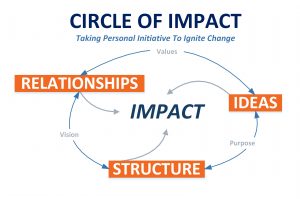When I first came up with the idea of the Circle of Impact two decades ago, I was responding to the patterns of behavior that I saw in people and organizations. In a real sense, their problems originated in the way they thought, the way they related to people, and the way they organized their world.

Out of that perception came the notion that there are three aspects of our lives – ideas, relationships, and structure – that represent the connective tissue of who we are and the world that surrounds us. I called them, The Three Dimensions of Leadership. At that time, I did not actually know how they were connected. I just knew they were. I could see it. It took many years to fully understand how fundamental a perspective I had discovered.
Ideas
One of the dilemmas of explaining this model for helping us is how these three dimensions connect together. It is easy to see how ideas live in an abstract space of words in the air or on a page. We think with ideas. I am not sure that we understand how significant they are in connecting to the world. In particular, words as ideas connect us to meaning. We like to hear a certain song or smell a forgotten aroma, and we are immediately catapulted to a particular place and time. We not only remember when but why and how it matters. The connection between our senses and past time is described in words of meaning. This is also the difficulty of emotional trauma. A word can trigger in us an emotional memory that puts us in that bad place again. Words are the connective tissue of meaning to link us to people and places.
Relationships
Our relationships are the most visible form of connection that we have. We connect with others at the office, at the gym, at home, at school, at the bar, and in a wide variety of extracurricular activities.
One of the insights that people are discovering through their experience with social media is that there is a difference between being socially connected digitally, online, and being in a direct relationship. No one I know would ever suggest that our social media connections should be ones of mutual accountability. Our connection online is much more a cultural expression, rather than an interpersonal one. They are not exclusive to one another. However, it is clear to me that almost none of my 2787 friends on Facebook know what I am doing from day to day before it happens. We report back to our connections what we have done. We post pictures and videos about yesterday, not the future. We share with our relationships what we are going to do.
We talk using words expressing the meaning of the intimate details of our lives. Our connections to people, as a result, happens at two levels. There is the superficial level of social media and the deeply personal level of our relationships with family and friends. Our problems arise when we get the two mixed up. When we treat social media interaction as deeply personal, self-defining, and take for granted the significance of our loved ones as those people who will always be there for us.
Structure
To speak about structure, I want to use two words. One is place and the other is infrastructure.
Until the COVID pandemic forced us to work from home, we went to the place where we worked. This place is a product of human thought and construction. I’m not sitting at a virtual desk, but a real one. It is old. It belonged to my mother as a child. It is unlike other desks that I have worked at over the years. It has a character that identifies not only its use but also reflects the creative imagination of the person who designed and built it. It is my place for work.
Infrastructure is how the world we live in is organized. We drive on roads, across bridges, through tunnels, and into parking garages. We walk into a building, ride the elevator to our floor, walk down the hall, and into a well-lit conference room where a meeting will take place. At that table, there is present an organizational structure in human form made up of the hierarchy of the people who work in the organization. These various forms of infrastructure provide the skeleton to the body of the organization. The people provide the flesh and living tissue.
The Dimensions Connected
These three dimensions are each connective within themselves. Words connect to create language. We don’t speak or write in single words but in sentences and paragraphs of words connected together. People connect together to create community. We each may be unique individuals. But we are not just individuals. We are people for whom life forms out of our connection to others. We don’t just associate like similar objects on a shelf. We interact. We select who we want to spend time with, who we love, who we marry, who we want to avoid, and who to ignore. We connect in patterns that represent the full diversity of humanity. The physical and organizational structure of our world connected together in places that make work, recreation, friendship, and family more easily managed. Structure is so prevalent we can’t even see it. It is the context of our lives, just like water is to fish.
These three dimensions connect us together like the tissue in our bodies. We are not collections of parts. We are whole beings. The three dimensions point to how we are not just whole persons as human beings. We are also persons who live in the connective tissue of our words, our relationships, and the structures of our lives. They are not separate but connected and whole.
The Connection Matters
You may ask, “Why is he rambling on about this?”
It is for the simple reason that we are living in a time where the connective tissue of our lives is being pulled apart. Fear clouds our minds creating doubt. Isolation from people has disrupted our patterns of relationships. The structural fundamentals of work are in transition. It isn’t just the hybrid nature of the workweek. It goes much deeper to will work be in the future.
What should we do? Here are three things.
Think clearly and for yourself.
Know your own mind. If you have not before, begin writing down notes during the course of your day. Carry a little notebook or use the audio recording function on your phone to capture thoughts that you have in the moment. This little discipline will help you translate what you think about what you hear into words that provide meaning and context for you. By writing, you can find your own voice. When you can do that, then you will be able to discern not just the truth or falsity of what you hear, but the motivations of those who are speaking to you. More importantly, you will know you own mind.
Be intentional about how you relate to people.
My practice is to set up networks of relationships. I use the chat platforms of FB messenger, Whatsapp, and Telecom for this. In my networks, we talk regularly, weekly mostly, if not daily. Some of these networks are just two of us. Some have more people connected. We talk, share, plan, and schedule. It is through these networks that the three dimensions have the opportunity to be aligned for making a difference that matters.
Don’t settle for a compromised life.
We are asked every day to accommodate ourselves to other people’s and institutions’ conception of what our lives should be like. The pressure to conform is greater today than at any time in my lifetime. The more you compromise in a manner that goes against what you believe, the harder it is to resolve the issues of doubt, fear, and loneliness. One of the questions that I ask when I conduct an Impact Day process is “What do you want to change?” This question points us toward an understanding of what impact means. What is the impact on your life? It is going to be worked out in the places and through the infrastructures where you spend your day. When you learn to think for yourself, you can then see the impact that you want as the result of the way you live. What do you want to change? What kind of impact do you want to see in your relationships and through our work? What you may find is that you need a plan to restructure your life in order to get where you really want to go. Knowing where you want to go is a very good thing.
Think Clearly. Be Intentional. Don’t Settle.
This is how can restore our perception of the connected tissue of our lives. When we do, a difference that truly matters will show itself.
If you’d like to know more or even learn how to create your own network of relationships, click on the link for my newsletter.


